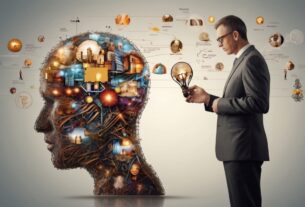Technological Innovation:
Technological innovation has always been a driving force in human progress. From the invention of the wheel to the rise of artificial intelligence, every major leap in technology has reshaped the way we live, work, and interact with the world. In today’s rapidly evolving digital era, the impact of innovation is more profound and far-reaching than ever before. It influences virtually every aspect of our lives, from how we communicate and travel to how we receive healthcare and participate in the global economy.
While the term “technological innovation” often conjures images of shiny gadgets and advanced algorithms, its true value lies in the transformative changes it brings to both the economy and society. It’s about more than just convenience or efficiency—it’s about empowerment, accessibility, and opportunity. In this article, we will explore the multifaceted benefits of technological innovation, focusing on its economic and societal impacts, and how it is shaping a better future for all.
Driving Economic Growth Through Innovation
One of the most visible impacts of technological innovation is its contribution to economic growth. New technologies create new industries, revitalize existing ones, and disrupt outdated business models. This cycle of innovation fuels productivity, increases efficiency, and opens up avenues for wealth creation.
Job Creation and Economic Diversification
Although there’s a common fear that technology will replace human jobs, the reality is more nuanced. While automation may phase out certain roles, it simultaneously creates new ones that didn’t exist before. For example, the rise of e-commerce has created millions of jobs in logistics, customer service, and digital marketing. Likewise, the growth of the renewable energy sector, powered by technological advances, is generating employment opportunities worldwide.
Technological innovation also fosters economic diversification. Countries that embrace tech-driven industries can reduce their dependence on traditional sectors like agriculture or manufacturing, which are often vulnerable to global market fluctuations. This diversification not only stabilizes national economies but also makes them more resilient in times of crisis.

Boosting Productivity and Efficiency
Technology enhances productivity by enabling faster, smarter, and more accurate work. Automation tools, artificial intelligence, and machine learning algorithms streamline complex tasks, allowing businesses to operate more efficiently. In agriculture, for instance, precision farming uses GPS and data analytics to optimize crop yields, reducing waste and maximizing output.
Similarly, in the manufacturing sector, robotics and smart systems have revolutionized production lines, significantly reducing costs and improving quality. These innovations allow companies to scale up operations and meet growing demands without proportionally increasing labor or resource input.
Facilitating Global Trade and Market Access
The internet and digital platforms have broken down geographic barriers, giving even the smallest businesses access to global markets. A craftsperson in a remote village can now sell their products to customers across continents, thanks to e-commerce platforms and international shipping solutions. This democratization of market access levels the playing field and encourages entrepreneurship on a global scale.
Moreover, digital payment systems, blockchain technology, and fintech innovations are streamlining international transactions, reducing fees, and increasing transparency. These tools are especially valuable for developing countries looking to integrate into the global economy.
Empowering Society Through Technological Innovation
Beyond economics, technological innovation plays a crucial role in societal development. It enhances quality of life, promotes equality, and enables communities to address pressing challenges such as health, education, and sustainability.
Transforming Healthcare and Saving Lives
Perhaps one of the most impactful areas of technological innovation is healthcare. From wearable health monitors to AI-assisted diagnostics, technology is revolutionizing how we approach medical care. Patients can now consult with doctors remotely through telemedicine, access their health records online, and receive personalized treatment plans based on genetic analysis.
During the COVID-19 pandemic, innovation played a critical role in vaccine development, contact tracing, and remote patient care. The rapid development and distribution of mRNA vaccines underscored how technology can accelerate solutions in times of crisis.
In developing countries, mobile health solutions are providing vital services in regions lacking medical infrastructure. Simple text-based apps can deliver prenatal care advice, medication reminders, and health education to underserved populations, helping to close the healthcare gap.
Expanding Access to Education
Technology has the power to make education more inclusive, personalized, and effective. Online learning platforms, virtual classrooms, and educational apps are transforming the traditional education model, making learning accessible to anyone with an internet connection.
This shift is especially meaningful for students in remote areas, people with disabilities, or those who cannot afford formal education. Through platforms like Khan Academy, Coursera, or Duolingo, individuals can acquire new skills, improve literacy, and pursue lifelong learning opportunities.
Moreover, adaptive learning technologies can tailor educational content to a student’s specific needs, helping to bridge learning gaps and improve outcomes. Teachers also benefit from tech tools that assist with lesson planning, assessment, and student engagement.
Enhancing Communication and Social Inclusion
Innovative communication tools have redefined how we connect with others. Social media platforms, instant messaging apps, and video conferencing solutions allow people to maintain relationships across vast distances. For marginalized communities, these tools can be a lifeline—offering platforms for advocacy, support, and social change.
For instance, individuals with hearing or speech impairments can use text-to-speech apps, while those with visual impairments benefit from screen readers and voice assistants. Technology is increasingly designed with accessibility in mind, fostering a more inclusive society where everyone can participate fully.
Strengthening Civic Engagement and Transparency
Technology also empowers citizens to become more informed and engaged in civic life. Digital platforms enable people to access information about government policies, participate in online forums, and hold public officials accountable. Tools like blockchain are being explored to ensure secure and transparent voting systems.
Additionally, open data initiatives and mobile apps help communities report issues such as potholes, pollution, or corruption, directly to local authorities. These innovations increase governmental responsiveness and promote a culture of transparency and accountability.
Environmental Sustainability and Innovation
Addressing climate change and environmental degradation is one of humanity’s greatest challenges—and technology offers powerful tools to help. From clean energy to smart cities, innovation is central to building a more sustainable future.
Renewable Energy and Smart Grids
Advances in solar, wind, and hydroelectric technologies are making renewable energy more efficient and affordable. Battery storage systems and smart grids allow for better management of energy supply and demand, reducing reliance on fossil fuels.
These innovations not only reduce greenhouse gas emissions but also bring energy access to remote and underserved regions. In places where traditional infrastructure is lacking, off-grid solar solutions are empowering communities with reliable electricity for the first time.
Sustainable Agriculture and Resource Management
Technology also supports sustainable agricultural practices. Drones can monitor crop health, soil sensors optimize irrigation, and AI models predict pest outbreaks. These tools help farmers produce more with less, reducing environmental impact and conserving precious resources like water and arable land.
Additionally, innovations in waste management—such as recycling robots and composting technologies—are helping to tackle pollution and reduce landfill use.
Smart Cities and Urban Planning
The concept of smart cities involves using data and technology to improve urban living. Sensors can monitor air quality, traffic flow, and energy usage in real time, enabling better planning and decision-making. Smart public transportation systems reduce congestion and emissions, while green building technologies minimize environmental footprints.
These efforts contribute to more livable, resilient cities that meet the needs of growing urban populations while protecting the planet.
Challenges and Ethical Considerations
While the benefits of technological innovation are vast, they come with challenges that must be addressed thoughtfully. Ethical concerns, digital divides, and unintended consequences can hinder the equitable distribution of innovation’s benefits.
Bridging the Digital Divide
Not everyone has equal access to technology. In many parts of the world, lack of internet connectivity, digital literacy, or affordable devices creates a digital divide. This gap exacerbates existing inequalities and limits opportunities for millions of people.
Governments, NGOs, and the private sector must work together to expand infrastructure, offer digital skills training, and ensure that innovation reaches the most vulnerable communities.
Ensuring Ethical Use and Privacy
As technology becomes more integrated into daily life, issues of privacy, surveillance, and data security gain prominence. AI algorithms, for example, can be biased or opaque, leading to unfair treatment in areas like hiring, lending, or law enforcement.
Regulations, transparency, and ethical frameworks are essential to ensure that technological advancement does not compromise fundamental rights and freedoms. The development of technology should always be guided by principles of justice, equity, and human dignity.
Managing Technological Disruption
Innovation often disrupts traditional industries and ways of life. While change can be positive, it can also cause dislocation and uncertainty. Workers displaced by automation need support, retraining, and opportunities to transition into new roles.
Policies that promote inclusive growth and social safety nets can help society navigate these shifts more smoothly, ensuring that the benefits of innovation are shared broadly.
Conclusion: Building a Better Future Through Innovation
Technological innovation is more than a catalyst for change—it is a cornerstone of human advancement. When guided by ethical principles and inclusive policies, innovation has the power to transform economies, uplift societies, and safeguard the planet for future generations.
From economic revitalization to social empowerment, from personalized healthcare to clean energy solutions, technology touches every part of our lives. By embracing innovation responsibly, we can address the world’s greatest challenges and create a more equitable, sustainable, and prosperous future for all.
As we stand on the brink of the next wave of technological breakthroughs—whether in quantum computing, biotechnology, or space exploration—one thing is clear: the true power of innovation lies not just in what it can do, but in what it enables us, as a global society, to become.
Technological Innovation:
Frequently Asked Questions (FAQ)
1. What is technological innovation?
Technological innovation refers to the development and application of new technologies or the significant improvement of existing ones. It includes everything from digital tools and software to medical devices and renewable energy systems that enhance efficiency, productivity, and quality of life.
2. How does technological innovation benefit the economy?
Technological innovation boosts the economy by increasing productivity, creating new industries and job opportunities, streamlining business processes, and enabling global trade. It also supports economic diversification and resilience in both developed and developing countries.
3. Can technological innovation create jobs, or does it mostly replace them?
While some jobs may be automated or replaced by machines, innovation often creates new roles that didn’t exist before—especially in tech, healthcare, logistics, and renewable energy sectors. It also opens up opportunities for entrepreneurship and remote work.
4. What role does technology play in improving healthcare?
Technology enhances healthcare through telemedicine, AI-powered diagnostics, wearable health monitors, and personalized treatment plans. It also enables faster vaccine development and improves access to healthcare services in remote or underserved areas.
5. How does technological innovation improve access to education?
Innovative educational tools like online learning platforms, virtual classrooms, and mobile apps make education more accessible, inclusive, and personalized. These tools help students in remote regions, people with disabilities, and adults seeking lifelong learning opportunities.
6. In what ways does technology promote social inclusion?
Technology promotes inclusion by providing accessible communication tools, supporting individuals with disabilities, and offering platforms for marginalized voices. It helps connect people globally, breaks down social barriers, and fosters civic engagement.
7. How is innovation helping to protect the environment?
Technological innovation supports sustainability through renewable energy, smart grids, sustainable agriculture, and smart city infrastructure. These innovations reduce waste, lower emissions, and promote more efficient use of natural resources.
8. What is a smart city, and how does it work?
A smart city uses digital technology, sensors, and data analytics to manage resources and services efficiently. This includes optimizing traffic flow, monitoring air quality, conserving energy, and improving public services like transportation and waste management.
9. What challenges come with technological innovation?
Challenges include the digital divide, ethical concerns about privacy and data use, and the disruption of traditional industries. Managing these challenges requires inclusive policies, regulation, and a commitment to ethical innovation.
10. What is the digital divide, and why does it matter?
The digital divide refers to the gap between those who have access to modern information and communication technologies and those who do not. Bridging this divide is essential to ensure that everyone benefits from innovation equally, regardless of location or income.
11. How can we ensure that technological innovation is ethical?
Ethical innovation requires transparency, inclusive design, data privacy protections, and unbiased algorithms. Governments, companies, and civil society must collaborate to create regulations and standards that uphold human rights and social justice.
12. What is the future of technological innovation?
The future holds breakthroughs in fields like AI, biotechnology, quantum computing, and space exploration. These innovations have the potential to further transform society, address global challenges, and unlock new opportunities for progress and collaboration.
Read also :




